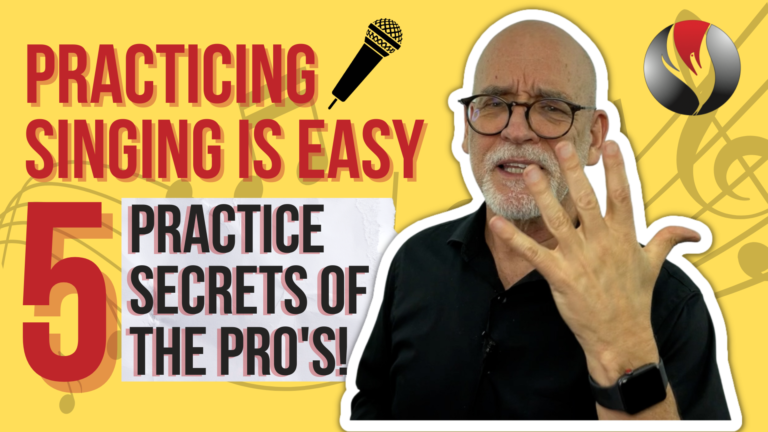In this video you’ll get three vocal exercises on how to sing high notes for guys without falsetto. These exercises work for girls’ voices too. Watch!
Hi I’m Chuck Gilmore, International Vocal Coach and Founder of Power To Sing.
Each week I teach you lessons in vocal technique so you can build a powerful and confident singing voice. If you’re new to my channel, please subscribe and click the bell so you’ll be notified when I post special videos for you each week!
The number one problem for most singers is how they sing high notes. Too often they stretch and strain upward to try and reach the notes. [Demo] Then they break into falsetto! [Demo]
First, I’ll explain why you’re straining and what happens when you do. Second, I’ll show you why falsetto doesn’t work as well as head voice. Third, I’ll give you three simple exercises that will stop the straining so you can sing much better high notes in head voice instead of falsetto. Ready?
#1. Why do you strain when you sing high notes?
Straining to sing high notes is how most of us learn to reach the notes. We don’t know how to do it any other way. At least three bad things happen when we reach and strain.
- We physically stretch our necks upward trying to stretch our vocal cords to hit the high notes and this becomes a habit. [Demo]
- This habit of straining upward pushes the larynx higher like we’re swallowing and the outer neck muscles squeeze the vocal cords and chokes off our voices. [Demo]
- The result is we sound like we’re yelling. Our pitch goes flat. Often we crack, and/or break into falsetto. Suddenly everything sounds too light and breathy. [Demo]
#2. Three reasons why falsetto doesn’t work as well as head voice?
- When you break into falsetto, the vocal cord muscle disengages. As a result only the outer edges of the vocal cords are coming together. This produces a light and breathy tone. [Demo]
- When you break into falsetto you lose the tonal connection to chest voice. As you sing lower into your chest voice, your vocal cord muscle has to re-engage to get back into chest voice, causing a clunk or break feeling. Falsetto will not blend smoothly into chest voice. [Demo] Head voice will blend smoothly back into chest because the vocal cord muscle is always engaged. [Demo]
- If you spend years singing high notes in falsetto, the vocal cord muscle atrophies through lack of use. As you age, you develop a wobble in your voice. [Demo] The old adage, “If you don’t use it, you lose it” is true for the muscle in the vocal cords.
#3. Three simple exercises to stop the straining and breaking into falsetto
First, is the simple but powerful Bubble Lips. Bubble Lips does at least four things:
- keeps the larynx down,
- eliminates the squeeze from outer neck muscles,
- enables the vocal cord muscle to adjust for head voice without disengaging and
- allows an easy transition of resonance from chest, through the bridge, into head voice and back down again.
It sounds like this with a 1 ½ scale. [Demo] Men first then the ladies. Both voices go up two half steps in this exercise.
Ready men, begin. [B2-C#3]
Now ladies it’s your turn. Ready, begin. [F#3-Ab3]
Second, is the exaggerated “ney”. [Demo] The “ney” does at least two things. It
- lightens the chest voice [demo]
- while on the upper notes, it strengthens or deepens the connection so you don’t break into falsetto.
Here’s a Tip: Don’t do it loud. Just exaggerate and firm enough to maintain the engaged vocal cord muscle…in other words, just firm enough that you don’t break into falsetto, but stay in head voice as you go higher. [Demo]
It sounds like this using the same 1 ½ scale. [Demo] Men first then the ladies.
Ready men, begin. [B2-C#3]
Now ladies it’s your turn. Ready, begin. [F#3-Ab3]
Third, is the dopy “gee”. The dopy “gee” does the same thing as the Bubble Lips only it imposes the larynx down with the dopy sound. Find the dopy sound like this: Locate your larynx by tracing your finger down to the middle of your neck until you feel the first bump. This is the top of the larynx. Your vocal cords are just behind this bump. Leave your finger on your larynx and Say “duh” with a dopy sound. [Demo] Not a normal “duh” but a dopy “duh”. [Demo] Can you feel the larynx pull lower? [Demo]
Tell me in the comments below if you can feel the larynx drop.[Demo] Do you feel it?
Now with this same dopey sound, say “gee”. [Demo]
Here’s a tip to help you be successful. As you sing higher, keep the dopy sound and relax into the upper notes. Allow the tone to go “hootie” like this. [Demo] Resist the temptation to grab the tone and pinch it like this. [Demo] Use the dopy sound on all the notes, including the bottom notes.
It sounds like this using the same 1 ½ scale. [Demo] Men first then the ladies.
Ready men, begin. [B2-C#3]
Now ladies it’s your turn. Ready, begin. [F#3-Ab3]
These exercises are very powerful and they’ll help you know how to sing high notes, guys or gals, without falsetto!
But these exercises are just the beginning. Let me explain how you can get more exercises to help your voice improve. Not just random exercises, but vocal exercises that are tailored specifically for your vocal type.
Your vocal type is not whether you’re soprano, alto, tenor or bass. Your vocal type describes what your voice tends to do as you sing higher. For example, do you tend to strain and/or break into falsetto?
There are exercises designed for your vocal type which eliminate problems unique to your voice.
To discover your vocal type, download this free PDF entitled “Get Your Vocal Type”. You can get it here, or in the description area below this YouTube video.
This PDF contains links to a simple vocal test. Take the test and get your vocal type.
Then learn about your vocal type by watching the videos. I show you how to do each of the exercises for your vocal type. Then you can download those exercises.
This PDF will give you links to the test, the videos and exercises for you to download so you can sing high notes in a strong, connected head voice, instead of having to break into falsetto.
Be sure to watch this video, “How to Sing High Pitch for Guys” for three simple secrets to singing high notes and ladies they work for you too.
IF YOU LIKED THIS VIDEO, PLEASE GIVE IT A THUMBS UP, SUBSCRIBE, AND SHARE IT WITH A FRIEND.
Also, to join a community of singers just like you, I invite you to join my Facebook page, Power To Sing, where I share up to date singing advice to help you succeed with your voice.
In addition, be sure to join me on Twitter and Instagram @powertosing.
I’m Chuck Gilmore with Power to Sing. You can sing higher with beauty, confidence and power. I’ll see you inside the next video.








Responses
Yes: https://youtu.be/-G-iqL75b0M at :45 seconds.
Thanks Chuck & I am practising these 3 exercises.
II find the ‘Bubble lips’ highest notes much more difficult than the ‘Exaggerated Ney’ and the ‘Dopey Gee’.
Can you give tips to improve the ‘Bubble lips’ exercise.
Raj